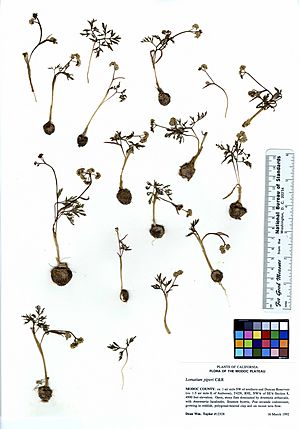Indian biscuitroot facts for kids
Quick facts for kids Indian biscuitroot |
|
|---|---|
 |
|
| Scientific classification | |
| Kingdom: | |
| (unranked): | |
| (unranked): | |
| (unranked): | |
| Order: | |
| Family: | |
| Tribe: |
Selineae
|
| Genus: | |
| Species: |
L. piperi
|
| Binomial name | |
| Lomatium piperi J.M.Coult. & Rose
|
|
Lomatium piperi is a type of flowering plant. It belongs to the carrot family. People often call it salt-and-pepper or Indian biscuitroot. In the local Sahaptin language, its name is mámɨn.
This plant grows naturally in the Northwestern United States and northern California. You can find it in places like sagebrush fields and high plateau areas. It also lives in the Sierra Nevada and Cascade Mountains.
About the Indian Biscuitroot
The Indian biscuitroot is a plant that lives for many years. It grows from a small, round underground part called a tuber. This tuber is usually less than one centimeter wide.
What it Looks Like
This plant typically grows to about 25 centimeters long. It usually does not have a main stem above ground. Instead, its leaves and flower clusters grow right from the ground.
The leaves are divided into many small parts. These parts are then split again into narrow, flat sections. The flowers grow in a cluster shaped like an umbrella, which is called an umbel. These flowers are white and have dark parts called anthers. Anthers are where the plant's pollen is made.

